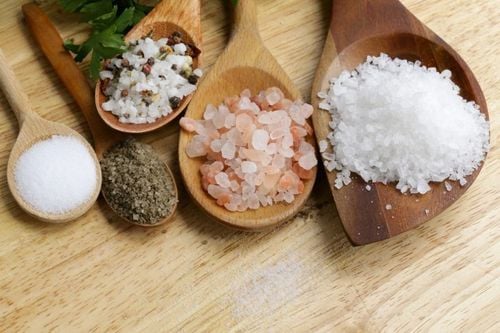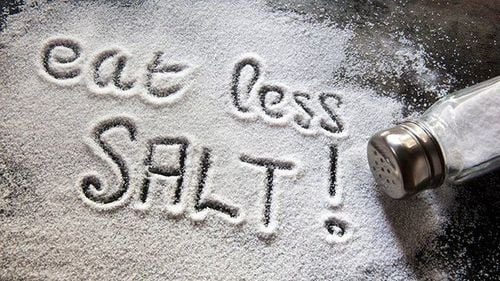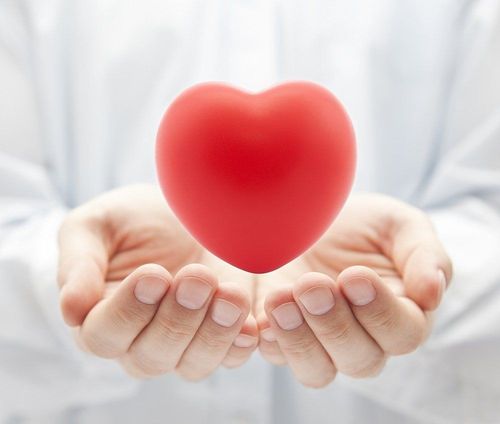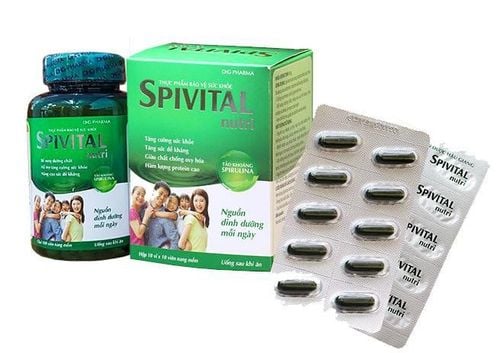This is an automatically translated article.
Salt is a very common spice in every family's kitchen. In addition to adding flavor to dishes, your body also needs a little salt each day to provide sodium for the body. But consuming too much salt can increase your risk of serious health problems.
1. How does eating too much salt affect health?
When the body absorbs too much salt, it will make the cells absorb water like a sponge. "Retention can increase blood pressure and increase pressure on blood vessels," says Lalita Kaul, a professor of nutrition at Howard University School of Medicine in Washington, DC. This increases the risk of stroke, kidney disease and heart attack. If you cut down on salt and eat it in moderation, it can help you lower and balance your blood pressure. People who eat less salt can reduce the loss of calcium from the bones, reducing the risk of osteoporosis and fractures. Especially for people with rheumatoid arthritis, they will feel the health effects of salt more clearly.
2. Eating too much salt is not a good thing. But how much is too much?
Nine out of 10 Americans eat more salt than they need. They averaged about 3,400 mg of sodium per day.
According to the Centers for Disease Control and Prevention (CDC), people over the age of 51, who have high blood pressure, kidney disease, or diabetes should consume an average of 1,500 mg (about half a teaspoon) of sodium per day. Healthy adults and adolescents 14 years of age and older should limit sodium intake to no more than 2,300 mg a day. Children under 14 need no more than 1,500 to 2,200 mg of sodium per day, depending on their age.
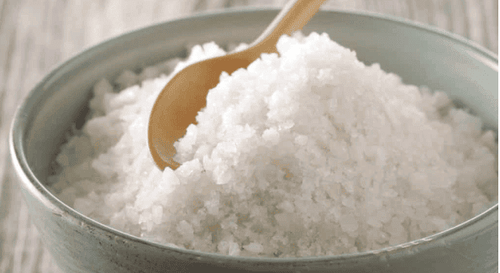
Bạn nên ăn ít muối hơn theo liều lượng được khuyến cáo
3. 8 ways to cut down on the amount of salt you consume each day.
To eat less salt, you don't have to change your eating habits suddenly. Use these everyday tips to help you form the habit of reducing the amount of salt in your diet.
3.1. The DASH Diet The DASH Diet is a good way to eat healthy. But there's no need to follow that particular diet to get measurable results.
Low-sodium dietary approaches to prevent hypertension such as DASH are a diet high in fruits, vegetables, and whole grains. This approach directs people to moderate amounts of nuts and low-fat dairy products, and less red and processed meat. Following it can lower blood pressure and reduce your risk of heart disease and stroke.
3.2. Read product ingredients We often forget to check product ingredients when making a purchase. However, you need to consider the ingredients in the product to ensure safety for your health. The higher the percentage of the word “Sodium” appearing on the ingredient list, the more salt there is in the product. Look for products labeled “sodium-free,” “low sodium,” or “sodium-free.”
Note: Read the nutrition facts carefully to check the amount of sodium in foods and compare different options to choose the best one. When you buy processed foods, choose ones that have less than or equal to the amount of sodium per serving. Try to choose products with 5% daily value (DV) or less. If the sodium content is 20% DV or more, it is high.
Check the nutrition facts to make sure you're not consuming too much salt!
3.3. Replace with another ingredient Instead of regular salt, look for low-sodium (Morton Lite Salt Mixture, LoSalt) and sodium-free (Salt Original, Morton Salt Replace) brands that help reduce some or all of the sodium. with potassium chloride for a similar salty taste. Also, good sources of potassium such as potatoes, cantaloupe, bananas, beans, milk and yogurt,...
If you have kidney disease or you are taking heart or blood pressure medication, talk to your doctor. doctor before using these salt substitutes, as they can increase your blood potassium levels. Sodium and potassium-free products (Maine Coast Kelp Granules, Benson's Table Tasty) contain dried seaweed or yeast. Since seaweed can interfere with thyroid function, use kelp seeds in moderation.
3.4. Watch out for salt when eating out. Foods such as french fries, burgers, etc. sold in some restaurants carry very high amounts of salt. So ask your waiter to ask the chef to add less salt. Better yet, eat meals you cook yourself. Alternatively, you can ask if there are any lower sodium dishes on the menu.
Some foods from restaurants or fast food can have 5,000 to 6,000 milligrams of sodium per serving, about four times the healthy daily limit. Reduce your portion sizes or try to choose products with a lower salt content.
3.5. Cook more at home Cooking your own meals is a great way to eat less sodium, because you control what goes into your food.
Rinse canned vegetables: rinsing thoroughly with cold water can reduce the salt content by almost half. Substitute seasonings: Using other herbs and spices instead of salt to season foods like pepper, ginger, garlic, lemon juice, and vinegar can all enhance flavor and make foods less bland. even without salt. Change breakfast foods: If you are a person who has a habit of eating breakfast with processed foods such as bagels and cereals, which are high in sodium. Look for low-salt or no-salt breads, yogurt, hash browns, and other breakfast foods. Switch from packaged cereals or instant oatmeal packets to quick-cooking oats. Change foods often: Fresh meats, fruits and vegetables, and whole grains are naturally low in sodium. In contrast, canned meat and soups, soup mixes, frozen or processed foods are often high in sodium.
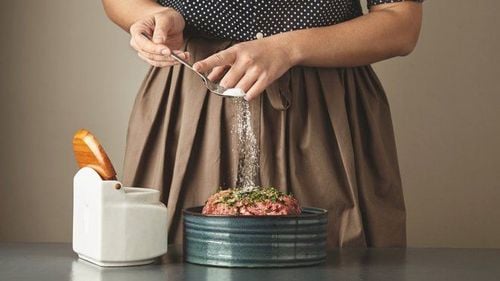
Nấu ăn nhiều hơn ở nhà giúp bạn ăn ít muối khi chủ động nêm nếm gia vị
3.6. Limit spices Vietnamese people often have the habit of adding many different spices to make the dish more flavorful. However, other condiments such as ketchup, mustard, pickles, olives, sauerkraut or soy sauce are almost always high in sodium. That will directly affect the health of you and your family.
"Out of sight out of mind". Just keep the salt container away or somewhere else so you can use less.
3.7. Buy low-sodium foods Sodium is found in most processed and prepared foods we buy, even foods that don't taste salty, like bread or tortillas.
When you go shopping, limit the following foods high in sodium:
Processed meats, poultry and seafood - like cold cuts, sausages and sardines Sausages, sauces and condiments Ready-to-eat foods , like rice or flavored noodles. Use this shopping list to find foods with lower sodium content when you are at the grocery store. Here are some food selection tips to help you make better choices:
Snack on unsalted nuts instead of salted crackers or chips. Choose skinless chicken and turkey, lean meat, or seafood instead of cold cuts or hot dogs. Choose fresh, frozen, or canned vegetables. Choose frozen vegetables without sauce and canned vegetables with the least sodium. Some of the highest sodium foods common in the American diet include: pepperoni pizza, white bread, cheese salami, spaghetti, ham, ketchup, wholemeal bread, ... If you also regularly eat these dishes, find ways to limit the appearance of these items on your menu.
3.8. Your “Taste Training” It will be difficult to change your taste buds quickly. But try to "train your taste buds" before it's too late. You should practice eating light, eat a little less salt every day. Time will help you get used to the new taste more beneficial for your own health.
Hope the above tips have partly helped you gain more information about the diet for good health. If you are wondering about how much salt your body needs, see your doctor so he can get the best advice for your health condition.
Please dial HOTLINE for more information or register for an appointment HERE. Download MyVinmec app to make appointments faster and to manage your bookings easily.
References: arthritis.org, health.gov, health.harvard.edu






